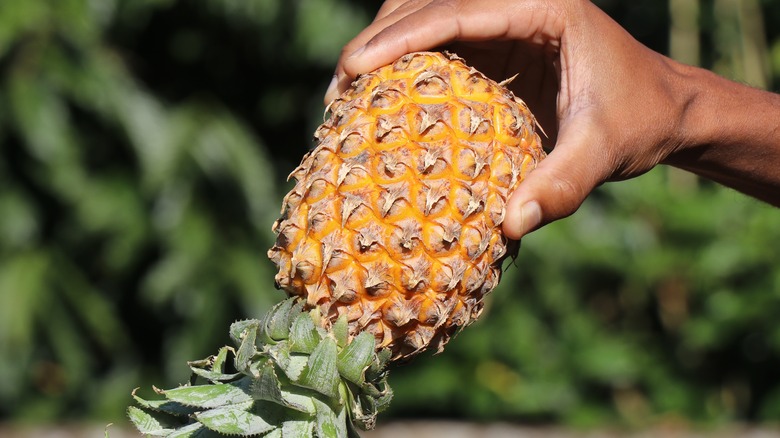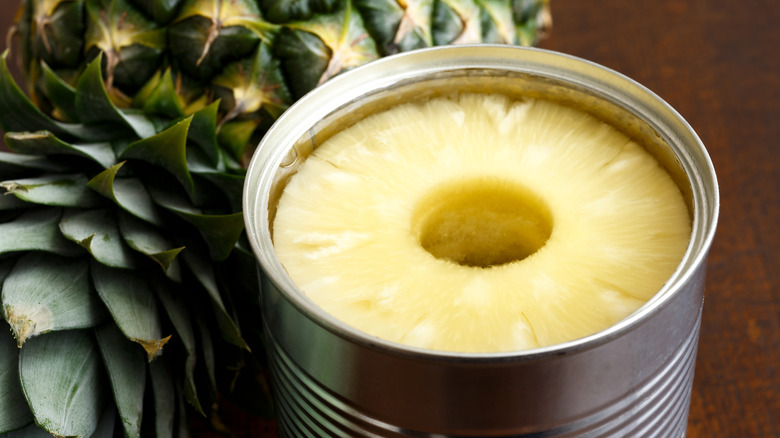Does Storing Pineapple Upside Down Actually Make It Juicier?
A viral kitchen hack for storing pineapples has social media head over heels. The gist of it is that pineapples kept upside down or on their sides will be sweeter than if left standing on their flat, bottom-heavy ends. Proponents on Instagram and TikTok claim that when a pineapple is stood upright, all its juicy goodness pools down at the bottom, draining away the precious sweetness from the rest of the fruit and leaving the top section leached high and dry. Thanks a lot, gravity. This theory is ostensibly backed up by the appearance of ripe pineapples, which are usually yellower and plumper at the bottom: a visual cue that the base of the fruit is where all the action is. Or is it?
Anecdotal evidence suggests that flipping a pineapple bottoms-up for anywhere from a couple of days to as little as half an hour before chopping it will get the juices flowing in all the right directions. By recycling the luscious liquids and sugars back throughout the pineapple's flesh, this simple trick of rotating the fruit is supposed to make it taste better through and through. But as it turns out, upending a pineapple to make it sweeter might be just a foodie myth.
Getting to the bottom of pineapple storage
To set the record straight, Eating Well interviewed William Goldfield at Dole Food Company, one of the largest and most well-known producers of pineapple in the world. According to Goldfield, a trick like "storing a pineapple upright or on its side doesn't make a difference."
While there is some truth to the bottom of a pineapple being sweeter than the top, this is due to the age of the fruit rather than anything to do with its juices settling. The lower portion of the pineapple is more mature, and therefore richer and juicier, than the newer growth toward its crown. Pineapples are picked fully ripe and will not ripen any further the way some fruits do, so the notion that storing them upside down can affect their flavor over time turns out to be an improbable idea. You can confidently skip the pineapple-inverting trend ... unless you really are making a pineapple upside-down cake.
The countless hacks and myths might make you wonder, though: Is all the fuss over proper pineapple storage and achieving the juiciest crop worth it? That's a resounding yes. Aside from being the hero of many tropical-inspired recipes, pineapple is a nutritional powerhouse. Packed with vitamins and minerals and high in bromelain (an anti-inflammatory), this fruit is as good for well-being as it is for the tastebuds — so you'll want to pick it up in its prime and keep it as fresh as possible through tried and tested means.
Picking a pineapple that makes the cut
How, then, can you make sure to get only the sweetest, most delicious pineapples? You need to know how to pick 'em. First, avoid any fruit that looks old, bruised, discolored, or dried out. Feel for soft spots before checking a pineapple as well; these are all sure signs it's past its prime. Once you've selected them, whole pineapples will keep well for two to four days in a refrigerator, and if cut, should be refrigerated in a lidded, airtight container.
There can be downsides to fresh, juicy pineapple, though. As it happens, the bromelain in that unprocessed fruit is to blame for mouth burn – the raw, tender, and tingly sensation some people experience when eating pineapple. Bromelain acts as a digestive enzyme, setting off the process that causes this irritating yet harmless, and thankfully temporary, discomfort.
To avoid letting mouth burn spoil the pineapple fun, you could try a salt water soak to preempt the sting, or forego the fresh version altogether and opt for canned pineapple instead. Owing to the modern-day miracles of food preservation, the heating methods used in canning take the bite out of bromelain, leaving behind only the mouth-friendly sweetness that makes pineapple such a versatile favorite. Now, whether you keep your cans stacked upside down in the pantry or not is between you and your pineapple, but just like the natural source from which it was made, the position in which you store the canned fruit is totally irrelevant to how sweet it will taste.



